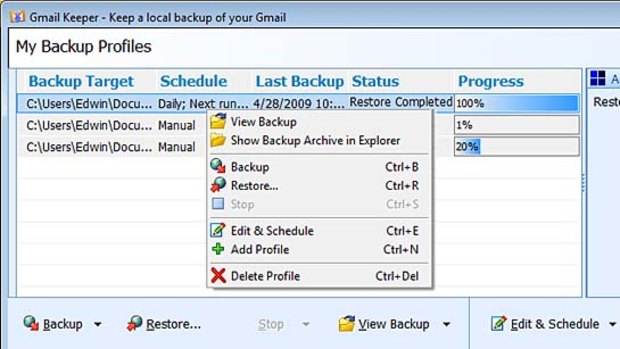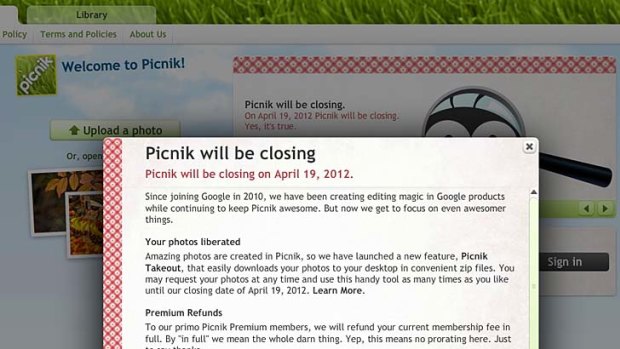This was published 12 years ago
Risks of putting digital life in cloud
Don't let a cloud burst leave your data all washed up, writes David Braue.
Later this month Google will close the shutters on Picnik.com, a popular online photo-editing site that Google bought in 2010 and is now being absorbed into the web giant's Google+ social-networking venture.
Picnik's users, many of whom have built up significant portfolios of work created with Picnik's Flash-based image editing tools, have been exhorted to download their images using Picnik Takeout – a feature that compresses all of a user's images into a compressed, downloadable .ZIP file. It's a one-time offer: once the site goes dark on April 19 (US time), every picture stored in the service will be gone.

A screenshot of Gmail Keeper.
Picnik isn't the first cloud service to close its doors, but it's a textbook example of the risks inherent in entrusting too much of your digital life to cloud-computing services. Web-based services like Apple's iCloud; file-sharing site DropBox; Adobe's Photoshop Express; Microsoft's new Office 365 apps and Windows Live services; photo-sharing sites like Facebook, Yahoo's Flickr and Smugmug; and Google Docs and related apps – these, and hundreds of other online services, are built around the idea that the software providers will look after your data for you, forever.
Since they promise to look after that data, you assume they're backing it up and will always make it available to you – but what if they don't, or can't? What if, as in the case of file-sharing site Megaupload, they are unexpectedly closed down. Or, as now-defunct hosting provider Distribute.IT found out last year in dramatic style, what if they're hacked, data protection measures fall over, and countless gigabytes of crucial customer data is lost?

Picnik will be closing April 19, 2012.
They're far from common, but disasters like these do happen; Google's Gmail service, for example, suffered a five-day outage last year that left over 30,000 customers without email. And that's why, despite the marketing hype and a high success rate in cloud migrations so far, Cloud Solutions Group managing director Josh Rubens advises his clients to make sure they maintain backups of everything they've stored in their cloud solutions.
Rubens recalls one customer that ignored his advice to install conventional backups and became distressed when their original cloud provider had a four-day downtime that severely disrupted the business; a replacement provider was sourced but suffered its own downtime a few months later. Eventually, the company gave in and set up their own on-site backup.
"Clouds fail and can fail regularly, just like on-premise infrastructure does," Rubens says. "But people are a lot more sensitive when their cloud provider fails. We always tell customers to have a disaster recovery plan in place: like any other part of an IT infrastructure, this data needs to be backed up."
Strategies for duplicating cloud data vary widely. For example, Dropbox data is stored on the local computer and generally included local computer backups; as long as you're backing up regularly, your files will be protected.
Other cloud services have different options. It's possible, for example, to set up your desktop email program – Outlook, Thunderbird and the like – to download mail from many online email services. You can also use tools like Gmail Keeper to maintain a running backup of your Gmail inbox, while Backupify does a nightly backup of data from Gmail and Google's other cloud services as well as Twitter, Facebook, Flickr, Blogger, Zoho and LinkedIn.
Small business owner Luke Humble, who runs graphic design business Pixel Perfection from his base in Hervey Bay, Queensland – has worked hard to ensure his reliance on cloud services doesn't leave the company high and dry. Gmail and Google Contacts, for example, are both downloaded to work computers using Outlook for continuous availability, and pushed to Humble's Samsung Galaxy S II smartphone.
"In the event my phone dies, I've got emails both in the cloud on my laptop – and vice versa," says Humble, adding that many of the firm's clientele have solicited advice on how to set up similar backups. "Our clients also need to make sure they have access to their data as and when and where they need it, so some of the solutions we've put in place for ourselves, we implement for those clients as well."
While there are many options for getting your data from mainstream cloud services, smaller or newer services may have enough fans to be supported by third-party apps: in such cases, once you put your data into the cloud, it's not going anywhere. Factor this into your decision-making, and consider favouring cloud services that offer obvious ways for you to get your data out it you want to back it up – or just want to take your data to a competitor.
Early cloud companies were focused on building awareness of their services, but startups are increasingly recognising that customers won't buy into the cloud if it leaves their data landlocked. "One of the things we advertise very clearly on the home page is that 'your data is your data'," says Justin Strharsky, managing director of new occupational health and safety startup Synaptor, which manages industrial safety data that's shared amongst field workers in real time using a social media-like interface.
"We value the fact that our customers are trusting us with that data, and we offer the functionality to take that data at any time," Strharsky says. "Some customers will be using that data to do additional analysis, and others will be using it to jump ship if they find a better solution. Either way, it keeps us honest."